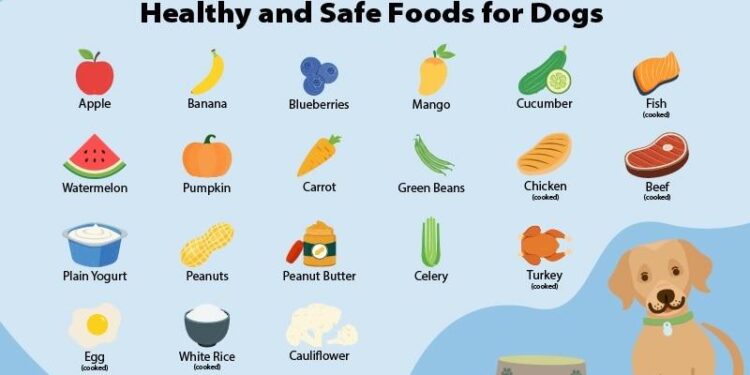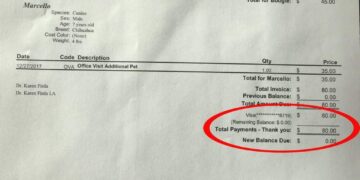Table of Contents
Introduction: The Wall of Bags
The dog food aisle at PetSmart is a monument to modern consumer choice.
It is a towering, multi-story wall of glossy bags, a kaleidoscope of vibrant packaging promising health, vitality, and a taste your dog will love.1
Bold-faced words leap out: “Natural,” “Holistic,” “Grain-Free,” “Ancestral Diet,” “Scientifically Formulated.” The sheer volume is staggering—over 1,600 different food products are available, spanning dozens of brands from the ubiquitous Purina Pro Plan and Hill’s Science Diet to the PetSmart-exclusive Simply Nourish and Authority.1
For the dedicated pet owner, this is the paradox of our time: we have never had more options to nourish our companions, yet we have never been more confused, overwhelmed, or anxious about making the right choice.3
This anxiety is not misplaced.
It stems from a deep-seated desire to provide the best possible care, a sentiment so strong that it creates what researchers call a “health prioritization gap.” A 2019 study revealed that over 43% of pet owners place a higher priority on buying healthy food for their pets than they do for themselves.5
When the stakes are this high, the pressure to decipher misleading labels and navigate conflicting advice becomes immense.
Owners report feeling that labels are deliberately confusing, and the internet offers a firehose of contradictory opinions, from Reddit threads debating the merits of corn to alarming news about food recalls and FDA investigations.5
This report is not another simplistic “best of” list.
Such lists fail to address the fundamental problem: the lack of a reliable framework for evaluation.
Instead, this is a journey.
It is a comprehensive guide designed to transform an owner’s anxiety into empowerment.
We will follow a relatable dog owner as they navigate this confusing landscape, and in doing so, we will deconstruct the complex world of canine nutrition.
We will learn the language of the dog food label, go beyond the bag to vet the manufacturer, and finally, apply this newfound knowledge to the very brands lining the shelves of PetSmart.
This is a roadmap to move past the marketing and make a confident, evidence-based decision for the dog you love.
Section 1: Meet Alex and Buster: A Story of Good Intentions
Persona Introduction
Alex represents the quintessential modern dog owner: well-intentioned, digitally savvy, and deeply devoted to their companion, Buster.
Buster is a spirited 3-year-old mixed-breed rescue, a picture of general health save for a few nagging concerns that keep Alex awake at night.
His coat, while full, lacks a certain luster.
He occasionally gets itchy, scratching without any obvious cause.
These are the low-grade, persistent worries that propel countless owners like Alex into the bewildering aisles of their local PetSmart, convinced that a “better” food is the solution.6
The Initial Failed Quest
On a Saturday afternoon, Alex and Buster walk into PetSmart.
The mission: find that “better” food.
Alex is immediately confronted by the wall of bags.
Promotional signs offer “$15 OFF” purchases of Hill’s, Pro Plan, Royal Canin, BLUE, Authority, or Simply Nourish.1
The sheer number of options is paralyzing.
Blue Buffalo alone has over 140 products; Purina Pro Plan and Royal Canin are not far behind.1
Alex has heard of these brands, of course, but the online chatter is a confusing mix of praise and condemnation.
Feeling lost, Alex’s eyes land on a bag with earthy tones and images of farm-fresh ingredients.
The marketing speaks of “wholesome goodness” and a “limited ingredient” formula.
The ingredient list on the back seems “clean”—no corn, no by-products.
This aligns with what Alex has gleaned from lifestyle blogs and forums.
For many owners, the ingredient list is the single most important factor in their purchasing decision, and a “clean” label feels like a safe harbor in a sea of confusion.5
Alex hefts the expensive bag into the cart, feeling a flicker of accomplishment, and heads home.
The Online Rabbit Hole
That flicker of confidence quickly fades.
Back at home, a nagging uncertainty prompts Alex to “just do a little more research.” This is the second phase of the modern pet owner’s quest, and it is often more bewildering than the first.
Alex falls down the digital rabbit hole, a disorienting world of conflicting truths.
The first stop is Reddit, a popular forum for pet owners seeking peer advice.9
In one thread, users passionately advocate for brands that meet the World Small Animal Veterinary Association (WSAVA) guidelines: Purina, Hill’s, Royal Canin, Iams, and Eukanuba.9
They speak of rigorous scientific testing and the importance of formulation by veterinary nutritionists.
Yet, in another thread, these same brands are derided as being full of “fillers” and “nothing but corn,” with users championing the very “boutique” and grain-free brands that Alex just purchased.6
This leads Alex to the most terrifying and confusing topic of all: the link between grain-free diets and a heart condition called Dilated Cardiomyopathy (DCM).
Alex finds the FDA’s 2019 announcement, which took the unusual step of naming 16 dog food brands most frequently reported in DCM cases, including popular names like Acana, Zignature, and Taste of the Wild.13
Over 90% of the implicated diets were grain-free, often containing high proportions of peas, lentils, and potatoes.15
The news sent shockwaves through the pet community, causing grain-free sales to plummet while grain-inclusive foods saw a massive surge.13
But the story doesn’t end there.
Alex then stumbles upon investigative reports suggesting the initial vets who prompted the FDA inquiry had financial ties to the major grain-based pet food manufacturers.13
Further digging reveals that the FDA quietly stopped issuing public updates on the investigation in December 2022, stating there was no “meaningful new scientific information to share” and acknowledging the issue was “a complex scientific issue that may involve multiple factors”.17
The agency never proved causation, only correlation, leaving owners like Alex in a state of perpetual uncertainty.15
The final straw is the anecdotal evidence.
Alex reads a heart-wrenching story from an owner whose dog suffered from constant ear infections and bloody stools, only to have all symptoms resolve after switching to a grain-free diet.19
Moments later, another post details a dog developing DCM-level heart values after years on a grain-free food.19
One dog’s cure is another’s potential poison.
Alex closes the laptop, more lost and anxious than ever.
The expensive new bag of dog food sits on the floor, no longer a symbol of proactive care but a question mark.
It becomes painfully clear that the problem isn’t a lack of information.
It’s the lack of a reliable framework to interpret that information.
The journey isn’t about finding more opinions; it’s about finding a methodology.
To choose the right food for Buster, Alex needs to learn how to cut through the noise, decode the marketing, and evaluate a food based on science, not fear.
Section 2: The Rosetta Stone: How to Read a Dog Food Label
Frustrated by the chaos of opinions, Alex resolves to learn the fundamental language of the industry.
If the dog food bag is a foreign text, then the label is its Rosetta Stone.
This section chronicles Alex’s—and by extension, the reader’s—journey into becoming a literate consumer, breaking down the label into its four most critical components.
Part 1: The Single Most Important Line – The AAFCO Statement
The first discovery is the Association of American Feed Control Officials (AAFCO).
Alex learns that AAFCO is not a government regulatory body that approves or certifies pet food.
Instead, it is a private, non-profit organization that establishes nutritional standards and model regulations for the industry, which are then adopted and enforced by state feed control officials.20
The most crucial piece of information AAFCO provides to consumers is the Nutritional Adequacy Statement.
This small block of text, often hidden on the back or side of the bag, is the first and most important filter for any food.22
It declares two things: the life stage the food is intended for (e.g., puppy/growth, adult maintenance, or all life stages) and, critically,
how the manufacturer determined the food is “complete and balanced”.22
Alex learns there are two primary statements to look for 25:
- “[Product Name] is formulated to meet the nutritional levels established by the AAFCO Dog Food Nutrient Profiles…”: This means the company created a recipe on paper or using software that, mathematically, should meet the minimum nutritional requirements. It’s a theoretical validation.26
- “Animal feeding tests using AAFCO procedures substantiate that [Product Name] provides complete and balanced nutrition…”: This is the gold standard. It means the company went beyond the recipe and actually fed the food to dogs for an extended period (typically six months) under strict protocols, monitoring their health to prove the food performs in a real-world biological system.20
This distinction is a revelation.
A food that has undergone feeding trials offers a much higher level of assurance than one that has only been formulated.
It’s the difference between a blueprint and a finished, road-tested vehicle.
Part 2: The Guaranteed Analysis – A Lesson in “Fake Math”
Next, Alex tackles the “Guaranteed Analysis,” the box of percentages for crude protein, fat, fiber, and moisture.24
At first glance, it seems straightforward.
But a critical insight emerges when comparing different types of food, like a bag of kibble and a can of wet food.
A typical dry kibble might list “24% crude protein” and “12% moisture”.27
A typical canned food might list only “8% crude protein” but “82% moisture”.27
The kibble seems far superior.
However, this comparison is meaningless because of the vast difference in water content.
To make a true, apples-to-apples comparison, one must convert the nutrients to a
Dry Matter Basis (DMB), which calculates the percentage of a nutrient after all the moisture has been removed.28
The calculation is simple but transformative.
For any given nutrient:
$$ \text{DMB %} = \left( \frac{\text{% Nutrient (as fed)}}{\text{100%} – \text{% Moisture}} \right) \times 100 $$
Applying this to the example foods reveals the truth.
The dry food’s protein on a DMB is $ (24 / (100 – 12)) \times 100 = 27.3% $.
The wet food’s protein on a DMB is $ (8 / (100 – 82)) \times 100 = 44.4% $.
Suddenly, the wet food is revealed to be significantly more protein-dense.
This single piece of knowledge empowers the consumer to see past the “as fed” numbers on the package and understand the true nutritional composition of what they are buying.
| Nutrient | Guaranteed Analysis % (As Fed) | Moisture % | Calculation: [% Nutrient / (100 – % Moisture)] x 100 | Result: % on Dry Matter Basis |
| Diet A (Dry) | ||||
| Crude Protein | 24% | 12% | (24 / 88) x 100 | 27.3% |
| Crude Fat | 10% | 12% | (10 / 88) x 100 | 11.4% |
| Diet B (Canned) | ||||
| Crude Protein | 8% | 82% | (8 / 18) x 100 | 44.4% |
| Crude Fat | 3% | 82% | (3 / 18) x 100 | 16.7% |
Part 3: The Ingredient List – Order, Weight, and Water
The ingredient list, which most owners consider paramount, is the next area of study.5
Alex learns the foundational rule: ingredients are listed in descending order by their pre-processing weight.24
What weighs the most goes first.
This leads to another key industry practice that can mislead consumers: the “water weight” trick.
Many premium brands proudly list a whole meat source like “Deboned Chicken” as their first ingredient.
This sounds wonderful, but whole chicken is about 70-75% water.
A “chicken meal,” listed further down, is a rendered, concentrated protein source with most of the water and fat removed.22
Therefore, a small amount of heavy, water-laden whole chicken can easily outweigh a larger amount of nutrient-dense, dry chicken meal, pushing the whole chicken to the top of the list for marketing appeal, even if the meal provides more of the food’s total protein.29
Alex also learns to define the terms, moving past the marketing-driven fear of certain words.
Using AAFCO’s official definitions, the distinctions become clear 22:
- Chicken: The clean flesh and skin, with or without bone.
- Chicken Meal: Rendered poultry tissue that has been cooked to remove water and fat, creating a concentrated protein and mineral powder.
- Chicken Byproducts: Non-rendered, clean parts of the carcass, which can include nutrient-rich organs like the heart, liver, and lungs, but excludes feathers, heads, feet, and entrails.
Understanding these definitions allows an owner to evaluate ingredients based on what they are, not just what they sound like.
“Byproducts” are not inherently bad; they can be a source of valuable nutrition.
The key is the quality and sourcing, information that isn’t available on the label itself.
Part 4: Decoding the Product Name – The AAFCO Naming Rules
The final piece of the puzzle is the product name itself.
Alex discovers that AAFCO has strict rules that dictate how much of a named ingredient must be in the food, turning the product name into a code.24
- The 95% Rule: If a product is named “Beef for Dogs,” at least 95% of the product (excluding water) must be beef. This is why such names are rare and usually reserved for single-ingredient treats.30
- The 25% Rule (or “Dinner” Rule): If the name includes a qualifier like “Dinner,” “Entrée,” “Platter,” or “Formula” (e.g., “Beef Dinner for Dogs”), the named ingredient(s) must make up at least 25% of the product (excluding water).30
- The 3% Rule (or “With” Rule): If the label says “Dog Food with Beef,” it only needs to contain 3% beef.30
- The “Flavor” Rule: A product named “Beef Flavor Dog Food” simply has to contain enough beef (or artificial flavorant) to be detectable. There is no minimum percentage.30
Armed with this knowledge, Alex can now walk down the PetSmart aisle and instantly decode the marketing.
A “Chicken Formula” is a world apart from a food “with Chicken.” This literacy is the first step in transforming from a passive consumer into a critical evaluator.
Section 3: Beyond the Bag: Vetting the Manufacturer with the WSAVA Checklist
Alex’s journey of discovery leads to a profound realization: the information on the bag, while useful for initial filtering, is incomplete.
The most important questions about a dog food’s quality, safety, and nutritional soundness cannot be answered by the label alone.
They must be directed at the company that makes it.
This paradigm shift introduces the gold standard for manufacturer evaluation: the guidelines published by the World Small Animal Veterinary Association (WSAVA) Global Nutrition Committee.32
WSAVA, like AAFCO, does not approve or endorse specific brands.32
Instead, it provides a checklist of questions designed to help veterinarians and discerning owners assess the expertise, quality control, and scientific rigor of a pet food manufacturer.
This framework moves the evaluation from a superficial analysis of ingredients to a deep dive into the company’s entire philosophy and process.
The Key WSAVA Questions (The “Manufacturer’s Report Card”)
Alex creates a “report card” based on the core WSAVA questions, a tool to systematically vet any brand 26:
- Do you employ a full-time, qualified nutritionist? The key here is “qualified.” This means a PhD in animal nutrition or a board-certified veterinary nutritionist (a Diplomate of the American College of Veterinary Internal Medicine (Nutrition)). Some brands may use vague language, claiming their foods are “formulated by veterinarians,” but this is not the same as having a dedicated, credentialed expert on staff overseeing formulation and research.26
- Who formulates your diets, and what are their credentials? This is a direct follow-up. A reputable company should be transparent about the experts behind their products.35
- Do you own your own manufacturing facilities? While not a deal-breaker, a company that owns its plants has direct control over every stage of production, from ingredient sourcing to final packaging. If they use a third-party co-packer, what are the quality control and safety standards of that facility?.26 Instinct Pet Food, for example, highlights that its raw recipes are made in its own state-of-the-art facility, over which it has 100% control.34
- What are your specific quality control measures for ingredients and finished products? This question probes for specifics. Do they test every batch of ingredients upon arrival? Do they test finished products for nutrient content, pathogens, and contaminants? A company committed to quality will have detailed, multi-step protocols, such as supplier audits, microbiological testing of raw ingredients, metal detection, and a “positive release” program where products are not shipped until safety tests come back clear.34
- Do you conduct AAFCO feeding trials? As learned in the previous section, feeding trials are the most rigorous method for substantiating a nutritional adequacy claim. While not legally required, a commitment to this more expensive and time-consuming process signals a higher standard.36
- Can you provide a complete nutrient analysis for any of your diets? The “Guaranteed Analysis” on the bag only provides minimums and maximums for a few nutrients. A transparent company should be able and willing to provide a “typical analysis,” which gives the average amount of all essential nutrients in the food as-fed and on a dry matter basis.35 This is essential for managing specific health conditions.
- What product research or nutrition studies have you conducted, and are the results published in peer-reviewed journals? This is the ultimate mark of a science-based company. Investing in and publishing research demonstrates a commitment to advancing the field of canine nutrition, not just marketing products.26
Revisiting the DCM Controversy with New Eyes
Armed with the WSAVA framework, Alex can now look back at the confusing DCM controversy with clarity.
The debate ceases to be about a single ingredient—”are peas bad?” or “are grains good?”—and becomes a question of scientific process.
The brands that meet WSAVA guidelines, like Purina and Hill’s, have decades of feeding trials, extensive research libraries, and large teams of nutritionists.9
This long-term, evidence-based approach makes them inherently more cautious and less likely to chase short-term market trends, like the massive and rapid shift to grain-free formulations that may have introduced unforeseen variables into canine diets.15
The WSAVA framework provides a stable path through the storm, anchoring decisions in the manufacturer’s commitment to rigorous, long-term science rather than the latest marketing fad.
This new understanding doesn’t mean that every boutique brand is bad or that every WSAVA-compliant brand is perfect for every dog.
It means that the risk is better understood.
Choosing a food from a company that does not meet these guidelines means the owner is accepting a greater degree of uncertainty and placing more trust in the company’s marketing claims rather than its demonstrated scientific process.
To put this powerful tool directly into the hands of the reader, Alex’s “report card” is formalized into a practical checklist.
| The Empowered Pet Owner’s Manufacturer Checklist | Brand A: | Brand B: | Brand C: |
| 1. Expertise & Formulation | |||
| Employs a full-time PhD or board-certified veterinary nutritionist? (Y/N/Unclear) | |||
| Name/credentials of formulator available? (Y/N) | |||
| 2. Manufacturing & Quality Control | |||
| Owns their own manufacturing plants? (Y/N/Partial) | |||
| Can provide specific quality control protocols? (Y/N) | |||
| 3. Research & Substantiation | |||
| AAFCO statement based on “Formulation” or “Feeding Trials”? | |||
| Conducts and publishes peer-reviewed research? (Y/N/Unclear) | |||
| 4. Transparency | |||
| Provides a complete nutrient analysis upon request? (Y/N) | |||
| Provides calorie content per serving? (Y/N) | |||
| Provides contact info for nutritional questions? (Y/N) |
Section 4: The PetSmart Aisle, Revisited: An Expert Walkthrough
With a new methodology in hand, Alex returns to the PetSmart aisle.
The “wall of bags” is no longer an intimidating monolith but a series of distinct choices to be analyzed.
The anxiety is gone, replaced by a sense of purpose.
This section applies the two-step framework—label decoding followed by manufacturer vetting—to a curated selection of prominent dry food brands found at PetSmart, creating a blueprint for the reader’s own evaluation.
Category 1: The Science-Backed Leaders
These are the brands frequently recommended by veterinarians and known for meeting WSAVA guidelines, prioritizing extensive research and feeding trials over trendy ingredient marketing.9
- Example: Purina Pro Plan Sensitive Skin & Stomach Salmon & Rice Formula
- Label Analysis: The front of the bag highlights its purpose. The first ingredient is salmon, a high-quality protein source, followed by digestible carbohydrate sources like rice, barley, and oat meal.37 It contains no corn, wheat, or soy, a nod to consumer preferences.40 The guaranteed analysis shows a minimum of 26% crude protein and 16% crude fat.37 On a dry matter basis (assuming 12% moisture), this translates to approximately 29.5% protein and 18.2% fat. The AAFCO statement confirms it provides complete and balanced nutrition for adult maintenance, substantiated through formulation and testing. The price for a large bag often falls in the range of $75-95, depending on size and retailer.37
- Manufacturer Analysis (WSAVA Checklist): Purina is one of the few companies that unequivocally meets WSAVA guidelines. They employ a large team of over 500 scientists, including veterinary nutritionists; own their manufacturing facilities; conduct extensive AAFCO feeding trials; and publish a wealth of peer-reviewed research.10 This is why, despite an ingredient list that may not seem as “gourmet” as some boutique brands, it is consistently recommended by the veterinary community.14
Category 2: The “Natural” Champions
These brands build their identity around what they don’t contain (by-products, artificial preservatives) and what they do contain (deboned meats, whole fruits and vegetables).
Their appeal is primarily ingredient-focused.
- Example: Blue Buffalo Life Protection Formula Adult Chicken & Brown Rice
- Label Analysis: The brand’s core promise is “real meat first,” and the ingredient list delivers with “Deboned Chicken” at the top.42 It prominently features its “LifeSource Bits,” a proprietary blend of antioxidants, vitamins, and minerals, and emphasizes the absence of chicken by-product meals, corn, wheat, or soy.44 The guaranteed analysis shows 24% protein and 14% fat 42, which converts to approximately 26.7% protein and 15.6% fat on a DMB (at 10% moisture). It is formulated to meet AAFCO profiles for maintenance.43 A 30 lb bag typically costs around $65.42
- Manufacturer Analysis: Applying the WSAVA checklist here requires more investigation from the consumer. While the ingredient philosophy is clear and appealing, questions about the number of full-time veterinary nutritionists on staff, the extent of peer-reviewed research published, and whether specific formulas undergo AAFCO feeding trials are less transparently answered compared to the science-backed leaders.
- Example: Wellness Complete Health Adult Deboned Chicken & Oatmeal Recipe
- Label Analysis: Similar to Blue Buffalo, Wellness leads with “Deboned Chicken” and markets itself as free of GMOs, meat by-products, and artificial preservatives.46 The guaranteed analysis lists 24% protein and 12% fat 48, translating to roughly 26.7% protein and 13.3% fat DMB. A 30 lb bag is priced around $69.46
- Manufacturer Analysis: This brand serves as a prime example of why the WSAVA questions are so crucial. Online discussions among informed owners and professionals suggest that Wellness has historically used careful wording that can imply they have veterinary nutritionists on staff without explicitly confirming it.26 This highlights the need for a consumer to be critical and seek direct, unambiguous answers from the company.
Category 3: The Exclusive Value Players
These are PetSmart’s in-house or exclusive brands, designed to offer the appeal of “natural” foods at a more competitive price point.
- Example: Simply Nourish Original Adult Dry Dog Food – Chicken & Brown Rice
- Label Analysis: This PetSmart-exclusive brand mirrors the marketing of the national “natural” brands, boasting “Deboned chicken is the #1 ingredient” and being “Free of colors, flavors or preservatives”.49 It is positioned as a wholesome, grain-inclusive option. The price is attractive, with a 40 lb bag costing around $60.51
- Manufacturer Analysis: While the front-of-bag claims are appealing, a deeper look reveals potential trade-offs. One third-party analysis site critiques the brand for using “feed grade” ingredients (which are not fit for human consumption) and a number of synthetic additives.52 Questions from consumers on the product page about mold, the use of chicken meal, and the carbohydrate content often go unanswered by the company, raising concerns about transparency.51 This demonstrates that a lower price point may come with compromises in ingredient quality or manufacturer accountability. Authority is another PetSmart brand that falls into this category, often promoted alongside Simply Nourish.2
Category 4: The Fresh & Frozen Frontier
A growing segment in the PetSmart freezer aisle, these foods cater to the ultimate consumer desire for less-processed, “real” food.53
- Brands: This category includes refrigerated rolls from Freshpet, frozen meals from JustFoodForDogs and Simply Nourish Fresh Market, and raw options from Instinct.53
- Analysis: The primary benefit of these diets is their high moisture content and palatability, making them excellent for picky eaters or dogs needing extra hydration.28 They often use human-grade ingredients, a powerful marketing claim.3 However, this comes with significant considerations. The cost per meal is substantially higher than kibble. Storage requires freezer or refrigerator space. And for raw diets specifically, both the FDA and WSAVA have issued warnings about the risk of pathogenic bacteria like
Salmonella and Listeria, which can pose a threat not only to the pet but also to the humans handling the food.28
To synthesize this analysis, a comparative table provides a clear, at-a-glance summary of the key trade-offs between these different brand philosophies.
| Comparative Analysis of Leading PetSmart Dry Dog Foods | Purina Pro Plan SSS Salmon & Rice | Blue Buffalo LPF Chicken & Brown Rice | Wellness Complete Health Chicken & Oatmeal | Simply Nourish Original Chicken & Brown Rice |
| Approx. Price/lb | $2.30 – $2.50 37 | $2.15 – $2.20 42 | $2.30 – $3.00 46 | $1.50 – $2.00 51 |
| First 5 Ingredients | Salmon, Rice, Barley, Canola Meal, Oat Meal 39 | Deboned Chicken, Chicken Meal, Brown Rice, Oatmeal, Barley 43 | Deboned Chicken, Chicken Meal, Oatmeal, Barley, Brown Rice 54 | Deboned Chicken, Chicken Meal, Brown Rice, Oatmeal, Barley 49 |
| Protein % (DMB) | ~29.5% 39 | ~26.7% 43 | ~26.7% 48 | Not readily available |
| Fat % (DMB) | ~18.2% 39 | ~15.6% 43 | ~13.3% 48 | Not readily available |
| AAFCO Substantiation | Feeding Trials/Formulation (Varies by formula) | Formulation 43 | Formulation 55 | Formulation |
| Key Marketing Claim | Targeted nutrition for sensitive systems, backed by science 38 | Real meat first; No corn, wheat, soy, or by-products 45 | Natural ingredients for whole-body health 55 | Natural ingredients at a value price 50 |
| WSAVA Alignment Note | Meets guidelines; extensive research and feeding trials 11 | Focus on ingredients; research and formulation expertise less transparent | Focus on ingredients; questions raised about nutritionist claims 26 | Exclusive value brand; transparency and ingredient sourcing may be a concern 52 |
Section 5: The Decision for Buster: A Confident Choice and a Clear Plan
The analysis is complete.
Alex stands at a crossroads, but it is no longer a confusing one.
The path forward is clear because it is paved with a sound methodology.
For Buster, with his specific, mild issues of a dull coat and occasional itchiness, the choice crystallizes.
Alex weighs the options: the “natural” brands offer appealing ingredient lists, but the science-backed brands offer targeted formulas developed through extensive research to address these exact problems.
The decision is made to prioritize the process over the poetry.
Alex chooses Purina Pro Plan Sensitive Skin & Stomach Salmon & Rice Formula.
This choice is not presented as a universal endorsement.
The narrative emphasizes that the process is the hero of this story, not the product.
Another owner, using the exact same framework but with a perfectly healthy dog and a tighter budget, might have validly chosen Simply Nourish, accepting the trade-offs in transparency for the significant cost savings.
An owner whose dog has severe, vet-diagnosed allergies might work with their vet to select a prescription diet or a limited ingredient food from a brand like Natural Balance.
The framework is universal; the conclusion is individual.
Alex feels confident not because an article declared this food “the best,” but because the decision was the logical outcome of a rigorous, evidence-based evaluation.
The Transition Plan
Making the choice is only the first step.
Alex knows that switching foods abruptly can lead to digestive upset like vomiting or diarrhea.56
A slow, gradual transition is essential.
Following the best practices recommended by veterinarians and many manufacturers, Alex devises a clear, 7-day plan (though a 10-14 day transition is even better for sensitive dogs) 43:
- Days 1-2: 75% old food mixed with 25% new food.
- Days 3-4: 50% old food mixed with 50% new food.
- Days 5-6: 25% old food mixed with 75% new food.
- Day 7: 100% new food.
This simple, actionable plan is a crucial final step that ensures the dietary change is as smooth and stress-free as possible for Buster.
Monitoring for Success
The final phase of the journey is observation.
A food’s success is ultimately measured by the health and well-being of the dog eating it.
Over the next few weeks, Alex will watch Buster for clear signs that the new food is a good fit 25:
- A good appetite: Does Buster eat his meals eagerly?
- High energy level: Is he playful and active, with normal stamina?
- Healthy skin and coat: Does his coat become shinier? Does the occasional itching subside?
- Good stool quality: Are his stools firm, consistent, and well-formed, without excessive gas?
- Stable body condition: Is he maintaining a healthy weight without needing to be fed significantly more or less than the bag’s recommendation?
This monitoring closes the loop, connecting the intellectual exercise of choosing a food to the tangible, real-world outcome for the pet.
Conclusion: From Anxious to Advocate
The journey began in the shadow of the “wall of bags,” a place of anxiety and confusion.
It ends with a single, confidently chosen bag of food and a clear plan of action.
The transformation was not the result of finding a magic answer or a secret “best” food that works for all dogs.
Such a thing does not exist.
The transformation came from acquiring a new language and a new lens through which to view the world of pet nutrition.
The modern pet owner is bombarded with marketing jargon, conflicting anecdotal evidence, and fear-mongering about ingredients.
This report has sought to cut through that noise by providing a durable, two-part framework.
First, by learning to decode the AAFCO statements, guaranteed analysis, and ingredient lists on the label, the owner can perform a crucial first-pass filter.
Second, by adopting the WSAVA guidelines for manufacturer evaluation, the owner can move beyond the bag to assess the true quality, safety, and scientific rigor of the company behind the food.
Alex’s journey from an overwhelmed consumer to an empowered advocate for Buster is the blueprint.
By understanding the difference between formulation and feeding trials, by learning to calculate nutrients on a dry matter basis, and by asking critical questions about a company’s research and quality control, any owner can navigate the PetSmart aisle—or any pet food marketplace—with clarity and confidence.
The ultimate goal is not to find the one perfect product, but to develop the one perfect process that allows you to make the best possible choice for the unique, individual dog who depends on you.
Works cited
- Healthy, Fresh Dog Food – PetSmart, accessed August 13, 2025, https://www.petsmart.com/dog/food
- Deals on dog food – Dry Dog & Puppy Food and Kibble – Shop by Brand | PetSmart, accessed August 13, 2025, https://www.petsmart.com/dog/food/dry-food/f/brand/authority
- 5 Common Mistakes Pet Owners Make When Choosing Pet Food, accessed August 13, 2025, https://www.petfoodaustralia.com.au/blogs/news/5-common-mistakes-pet-owners-make-when-choosing-pet-food
- Do you also feel overwhelmed by all the food choices for your dog or cat? : r/Pets – Reddit, accessed August 13, 2025, https://www.reddit.com/r/Pets/comments/1m8mrcs/do_you_also_feel_overwhelmed_by_all_the_food/
- Determinants of pet food purchasing decisions – PMC, accessed August 13, 2025, https://pmc.ncbi.nlm.nih.gov/articles/PMC6515811/
- Pet owners, when did you realize your pet’s food was actually the problem? : r/Pets – Reddit, accessed August 13, 2025, https://www.reddit.com/r/Pets/comments/1m35dsu/pet_owners_when_did_you_realize_your_pets_food/
- Dog Food Advisor: Dog Food Reviews and Ratings, accessed August 13, 2025, https://www.dogfoodadvisor.com/
- 10 Common Mistakes People Make When Picking Dog Food | FitBark, accessed August 13, 2025, https://www.fitbark.com/blog/10-common-mistakes-people-make-when-picking-dog-food
- Any good dog food recommendations? : r/dogs – Reddit, accessed August 13, 2025, https://www.reddit.com/r/dogs/comments/1hxb7fu/any_good_dog_food_recommendations/
- Looking for dog food recommendations : r/OpenDogTraining – Reddit, accessed August 13, 2025, https://www.reddit.com/r/OpenDogTraining/comments/1hpp5p7/looking_for_dog_food_recommendations/
- What is the consensus on the best puppy food? : r/puppy101 – Reddit, accessed August 13, 2025, https://www.reddit.com/r/puppy101/comments/1it4xtj/what_is_the_consensus_on_the_best_puppy_food/
- [Discussion] What do you think of dogfoodadvisor? : r/dogs – Reddit, accessed August 13, 2025, https://www.reddit.com/r/dogs/comments/c29uo1/discussion_what_do_you_think_of_dogfoodadvisor/
- Did Industry Funding Influence an FDA Investigation into Canine Heart Disease and Grain-Free Dog Food? – Paws on Chicon, accessed August 13, 2025, https://www.pawsonchicon.com/blogs/industry-news/did-industry-funding-influence-an-fda-investigation-into-canine-heart-disease-and-grain-free-dog-food
- What You Need to Know About Grain Free Dog Food and Heart Disease – Animal Emergency & Referral Center of Minnesota, accessed August 13, 2025, https://aercmn.com/what-you-need-to-know-about-grain-free-dog-food-and-heart-disease/
- FDA Investigation into Potential Link between Certain Diets and Canine Dilated Cardiomyopathy – February 2019 Update, accessed August 13, 2025, https://www.fda.gov/animal-veterinary/news-events/fda-investigation-potential-link-between-certain-diets-and-canine-dilated-cardiomyopathy-february
- Protect Your Pup: FDA’s New Warning on Dog Food Safety and Canine Heart Disease, accessed August 13, 2025, https://www.centerforfoodsafety.org/blog/5649/protect-your-pup-fdas-new-warning-on-dog-food-safety-and-canine-heart-disease
- FDA Investigation into Potential Link between Certain Diets and Canine Dilated Cardiomyopathy, accessed August 13, 2025, https://www.fda.gov/animal-veterinary/outbreaks-and-advisories/fda-investigation-potential-link-between-certain-diets-and-canine-dilated-cardiomyopathy
- Flaws in the FDA’s Study on DCM & Grain Free Pet Foods – YouTube, accessed August 13, 2025, https://www.youtube.com/watch?v=18WQUQ3Jo84
- Pet owners, when did you realize your pet’s food was actually the …, accessed August 13, 2025, https://www.reddit.com/r/Pets/comments/1m35dsu/pet_owners_when_did_you_realize_your_pets_food_was_actually_the_problem/
- AAFCO-Approved Pet Food: Everything You Need to Know | PetMD, accessed August 13, 2025, https://www.petmd.com/dog/nutrition/What-Is-AAFCO-and-What-Does-It-Do
- Understanding Pet Food | AAFCO, accessed August 13, 2025, https://www.aafco.org/consumers/understanding-pet-food/
- Selecting the Right Pet Food | AAFCO, accessed August 13, 2025, https://www.aafco.org/consumers/understanding-pet-food/selecting-the-right-pet-food/
- How to Read a Dog Food Label – American Kennel Club, accessed August 13, 2025, https://www.akc.org/expert-advice/nutrition/how-to-read-a-dog-food-label/
- Reading Labels | AAFCO, accessed August 13, 2025, https://www.aafco.org/consumers/understanding-pet-food/reading-labels/
- How to Choose the Best Dog Food | PetMD, accessed August 13, 2025, https://www.petmd.com/dog/nutrition/how-to-choose-the-best-dog-food
- How to look at dog food critically and avoid the marketing BS : r/DogFood – Reddit, accessed August 13, 2025, https://www.reddit.com/r/DogFood/comments/1bmn19h/how_to_look_at_dog_food_critically_and_avoid_the/
- Nutritional Requirements of Small Animals – Merck Veterinary Manual, accessed August 13, 2025, https://www.merckvetmanual.com/management-and-nutrition/nutrition-small-animals/nutritional-requirements-of-small-animals
- 4 Common Questions About Pet Food, accessed August 13, 2025, https://www.petfoodinstitute.org/4-common-questions-about-pet-food/
- Deciphering Dog Food Labels | VCA Animal Hospitals, accessed August 13, 2025, https://vcahospitals.com/know-your-pet/deciphering-dog-food-labels
- How to Read and Compare Dog Food Labels: A Beginner’s Guide – Jinx, accessed August 13, 2025, https://www.thinkjinx.com/blogs/news/how-to-read-and-compare-dog-food-labels-a-beginners-guide
- Pet Foods: How to Read Labels, accessed August 13, 2025, https://extensionpublications.unl.edu/assets/html/g1960/build/g1960.htm
- All You Need to Know About WSAVA – Dog Food Advisor, accessed August 13, 2025, https://www.dogfoodadvisor.com/choosing-dog-food/all-you-need-to-know-about-wsava/
- Nutrition Guidelines – WSAVA, accessed August 13, 2025, https://wsava.org/global-guidelines/global-nutrition-guidelines/
- WSAVA GUIDELINES – Instinct Pet Food, accessed August 13, 2025, https://instinctpetfood.com/wp-content/uploads/2021/08/wsava_updated_2021_final_v2.pdf
- WSAVA Guidelines & Transparent Nutrition | JustFoodforDogs Blog, accessed August 13, 2025, https://blog.justfoodfordogs.com/wsava-guidelines.html
- WSAVA Nutritional Assessment Guidelines, accessed August 13, 2025, https://wsava.org/wp-content/uploads/2020/01/WSAVA-Nutrition-Assessment-Guidelines-2011-JSAP.pdf
- Purina Pro Plan Sensitive Skin And Stomach Salmon And Rice Formula Adult Dry Dog Food, 40Lb | Pet Supermarket, accessed August 13, 2025, https://www.petsupermarket.com/dog/food/dry-food/purina-pro-plan-specialized-sensitive-skin-stomach-salmon-rice-formula-dry-dog-food/FCM01912.html
- Purina Pro Plan Sensitive Skin and Stomach Salmon and Rice Formula Dog Food, 40 lbs., accessed August 13, 2025, https://www.petco.com/shop/en/petcostore/product/purina-pro-plan-focus-sensitive-skin-and-stomach-salmon-and-rice-formula-adult-dry-dog-food
- Purina® Pro Plan Sensitive Skin & Stomach Adult Dry Dog Food – Salmon & Rice, No Corn, Wheat or Soy – PetSmart, accessed August 13, 2025, https://www.petsmart.com/dog/food/dry-food/purina-pro-plan-sensitive-skin-and-stomach-adult-dry-dog-food—salmon-and-rice-no-corn-wheat-or-soy-36648.html
- Specialized Sensitive Skin & Stomach Salmon & Rice Dry Dog Food – Pro Plan Vet Direct, accessed August 13, 2025, https://www.proplanvetdirect.com/pro-plan-reg-focus-adult-sensitive-skin-stomach-formula
- WSAVA Guidelines Dog Food | Petco, accessed August 13, 2025, https://www.petco.com/shop/en/petcostore/o/wsava-approved-dog-food
- BLUE BUFFALO Life Protection Formula Adult Chicken & Brown Rice Recipe Dry Dog Food, 34-lb bag – Chewy, accessed August 13, 2025, https://www.chewy.com/blue-buffalo-life-protection-formula/dp/28801
- Life Protection Formula Adult Dry Dog Food – Chicken & Brown Rice – Blue Buffalo, accessed August 13, 2025, https://www.bluebuffalo.com/dry-dog-food/life-protection-formula/chicken-brown-rice-recipe/
- Life Protection Formula™ Dry Puppy Food Chicken & Brown Rice Recipe – Blue Buffalo, accessed August 13, 2025, https://www.bluebuffalo.com/dry-dog-food/life-protection-formula/puppy-chicken-brown-rice-recipe/
- Blue Buffalo Life Protection Formula Adult Dry Dog Food, Chicken & Brown Rice, 5 lbs., accessed August 13, 2025, https://www.walmart.com/ip/Blue-Buffalo-Life-Protection-Formula-Adult-Dry-Dog-Food-Chicken-Brown-Rice-5-lbs/345081788
- WELLNESS Complete Health Adult Deboned Chicken & Oatmeal Recipe Dry Dog Food, 5-lb bag – Chewy.com, accessed August 13, 2025, https://www.chewy.com/wellness-complete-health-adult/dp/30140
- Wellness Complete Health Adult Deboned Chicken & Oatmeal Recipe Dry Dog Food, accessed August 13, 2025, https://chowhoundpetsupplies.com/wellness-complete-health-adult-deboned-chicken-oatmeal-recipe-dry-dog-food/
- Wellness Complete Health® Adult Deboned Chicken & Oatmeal – SmartPak Equine, accessed August 13, 2025, https://www.smartpakequine.com/ps/wellness-complete-health-adult-deboned-chicken-and-oatmeal–2547
- Simply Nourish – Original Large Breed Adult Dry Dog Food – Chicken & Brown Rice, accessed August 13, 2025, https://bottomless.com/products/simply-nourish–original-large-breed-adult-dry-dog-food–chicken–brown-rice
- Simply Nourish® Dog Food, Cat Food Official Website, accessed August 13, 2025, https://simplynourish.usabrandsmart.com/
- Simply Nourish® Original Adult Dry Dog Food – Chicken & Brown Rice – PetSmart, accessed August 13, 2025, https://www.petsmart.com/dog/food/dry-food/simply-nourish-original-adult-dry-dog-food—chicken-and-brown-rice-52763.html
- Simply Nourish Chicken & Brown Rice Recipe Small Breed Puppy Dry Dog Food, accessed August 13, 2025, https://sundaysfordogs.com/compare/simply-nourish-chicken-brown-rice-recipe-small-breed-puppy-dry-dog-food
- Fresh, Frozen & Raw Dog Food – PetSmart, accessed August 13, 2025, https://www.petsmart.com/dog/food/fresh-and-frozen-food
- Wellness Complete Health Natural Dry Dog Food, Chicken & Oatmeal, 5-Pound Bag, accessed August 13, 2025, https://www.petsuppliesplus.com/categories/dog/food/natural/dry/wellness-complete-health-natural-dry-dog-food-chicken–oatmeal/4258
- Wellness Complete Health Grained Chicken & Oatmeal | Wellness Pet Food, accessed August 13, 2025, https://www.wellnesspetfood.com/product-catalog/wellness-complete-health-grained-chicken-oatmeal/
- Wondering Which Dog Food is the Best? Learn How to Choose the Best Dog Food for Your Dog – Purina, accessed August 13, 2025, https://www.purina.com/articles/dog/feeding/guides/how-to-choose-best-dog-food
- How to Pick the Best Dog Food for Your Dog | Blog – Walk! ATX, accessed August 13, 2025, https://walkatxpets.com/blog-videos/how-to-pick-the-best-dog-food-for-your-dog/
- How to Choose Dog Food: The Ultimate Guide | Tractor Supply Co., accessed August 13, 2025, https://www.tractorsupply.com/tsc/cms/life-out-here/pet/dogs/dog-food-buyer-s-guide






